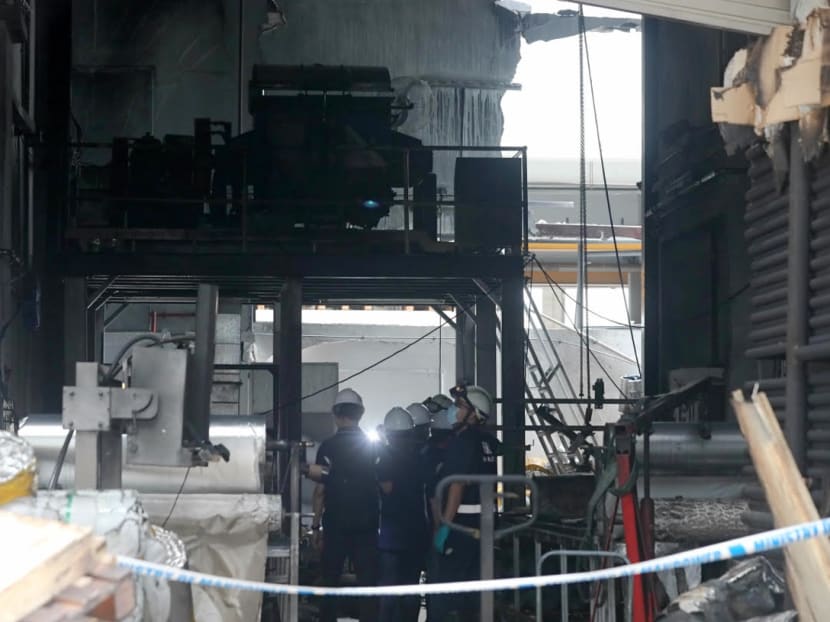Tuas industrial blast hearing: Workers raised 'red flags' with bosses for 6 months before explosion claimed 3 lives
SINGAPORE — An inquiry committee looking into an explosion that killed three workers at an industrial building in Tuas in February heard that workers had alerted their superiors to oil leaks, heater damage, smoke and small fires from as early as August last year.

- An inquiry committee began public hearings into an explosion and fire at an industrial building in Tuas
- Three workers died from burn injuries and another seven were injured in the February incident
- The committee heard evidence that some workers raised concerns about oil leaks, heater damage, smoke and small fires up to six months before the blast
- It is looking at the causes of the incident and whether obvious red flags were ignored
SINGAPORE — An inquiry committee looking into an explosion that killed three workers at an industrial building in February heard that workers had alerted their superiors to oil leaks, heater damage, smoke and small fires from as early as August last year.
For example, one of the workers, when alerting an engineer to a leak, had written in a few phone text messages in September last year: “Need to welding... Now small hole. Later big hole”.
The evidence emerged on Monday (Sept 20), the first day of public hearings by the committee to determine the circumstances leading to the blast at 32E Tuas Avenue 11, including whether obvious red flags were ignored. This first tranche of hearings is expected to run until Oct 8.
The committee began its investigations in March.
State Counsel Kristy Tan described the warnings from the workers as “red flags”. They related to a mixer machine that was purchased from Chinese online retailer Alibaba in 2019 and installed in the unit belonging to fire protection contractor Stars Engrg in June last year.
Just before the blast on Feb 24 at 11.22am, one of the workers, who later died as a result of the explosion, had sent a photo of a small fire that broke out at around 8.39am that same day and photos of a damaged heater to an engineer, who later forwarded the images to their boss.
The explosion took place less than 10 minutes after the worker, 38-year-old India national S Marimuthu, sent the photo showing the damaged heater with a green tape around its wiring. The engineer replied at 11.32am, about 10 minutes after the explosion: “Ok let me know ASAP.”
The committee, led by Senior District Judge Ong Hian Sun, heard that the engineer, Mr Lwin Moe Tun, deleted the photo with the green tape and his text reply from his and the worker’s phones after the incident.
The huge explosion was followed by flash fires. Singapore Civil Defence Force (SCDF) personnel arrived at the scene at 11.30am and the fires were put out by 11.46am.
Besides the three who died, seven other workers – five from Stars Engrg and two from a neighbouring unit – were injured in the accident. They suffered a litany of serious burn injuries, including burns that covered 35 per cent to 58 per cent of their total body surface area.
State Counsel Tan said that the impact from the blast was so intense that two of the men who were working outside the workshop, beyond its front shutters, were thrown 2m.
The three deceased — Marimuthu and Bangladeshi workers Anisuzzaman Md, 29, and Shohel Md, 23 — died from severe burns at various times over the following two days. In all three cases, about 90 per cent of their total body surface area was burnt, the committee heard.
MAIN QUESTIONS
The committee heard that the first two floors of Stars Engrg’s premises at the building were being used to make and store fire-rated insulation wrap. The third storey was used as dormitory housing for some of the workers.
A key component of the fire wrap was fire clay that was made by mixing water, potato starch, boric acid, silicon oil, aluminium trihydrate and bentonite clay using the mixer machine.
Mr Chua Xing Da is the sole director and sole shareholder of Stars Engrg. Mr Lwin Moe Tun is the engineer overseeing production at the Tuas site, while Mr Chua is in charge of production overall at the site.
Investigations into the blast found that the mixer machine had multiple instances of damage, but the bulk of the damage was at the lower portion of the back of its oil jacket, which contained thermic oil used to heat the contents in its mixing compartment, State Counsel Tan said.
The oil jacket had ruptured open along its welding seams, she added.
She said that the inquiry’s first order of business would be to determine the technical causes of the accident.
Quoting chemical engineering experts, she said that there appears to be agreement that it was a chemical explosion involving the ignition of thermic oil aerosols.
However, the experts differ on whether it occurred from the inside of the oil jacket or following a physical rupture of the oil jacket due to internal overpressure.
The committee would have to determine various technical questions in relation to the oil jacket’s weld seams, she said, including whether the heaters in the oil jacket over-heated, as well as the fuel source and the ignition source of the explosion.
Early investigations first established that the blaze was caused by the ignition of potato starch powder, which is combustible when dispersed in the air in a confined space.
State Counsel Tan said that an analysis of samples collected by Ministry of Manpower (MOM) investigators from surfaces and bulk samples of the workshop after the accident found that potato starch residue was present in various locations and surfaces in the workshop.
The inquiry will also delve into whether the potato starch powder had caused the flash fires.
In addition, State Counsel Tan stressed that it is relevant to establish if obvious red flags were ignored, as these were factors that created or contributed to the conditions that led to the blast.
She identified four categories of notable events leading up to the accident:
-
The presence of burned or damaged heaters
-
Leaks from the oil jacket
-
Smoke coming out from the bottom of the oil jacket
-
Fires at the mixer machine
WHAT HAPPENED
The state counsel gave a chronology of key events leading up to the accident to shed some light on the first four of these issues being considered. The following is a summary of what transpired.
-
Aug 7, 2020: Mr Lwin Moe Tun instructs a worker, a 34-year-old Bangladeshi named Imam, to make a batch of fire clay. While operating the mixer machine, Mr Imam suspects that the oil in the oil jacket was running out.
-
Aug 8, 2020: Mr Imam informs Mr Chua about the situation just after midnight. Mr Chua replies shortly after, saying, among others, “Oil all go where”, “F*** u la”, “All opening now close”, and “If not all the oil gone already”. In the morning, Mr Imam starts to make a batch of fire clay when a spark and smoke emits from one of the machine’s nine heaters. The damaged heater is then replaced with a new spare heater.
-
Aug 28, 2020: Mr Imam notices smoke coming out of the area where the mixer machine’s heaters are located. Mr Imam and another worker, Mr Mehedi, then drain the oil in the oil jacket to check the heaters and find black sediment in the oil, which had turned black. Gaskets on the heater openings of the oil jacket had also deteriorated. The worn-out gaskets are replaced by new ones, while the drained oil – minus the heavier black sediment, which had settled at the bottom of the buckets – is poured back into the oil jacket.
-
Sept 21, 2020: Mr Imam notices smoke or oil vapour coming out of the bottom of the oil jacket, near the heaters. Mr Imam tells Mr Lwin Moe Tun about it.
-
Sept 28, 2020: Mr Imam and Mr Mehedi notice a leak in the front bottom left corner of the oil jacket when the mixer machine is in use. Mr Imam also informs Mr Lwin Moe Tun about the leak, suggesting that the leak should be closed by welding.
-
Oct 1, 2020: Black sediment is again found in the oil in the oil jacket when drained.
-
Oct 12, 2020: Mr Mehedi tells Mr Lwin Moe Tun about an oil leak in the same area as the one discovered on Sept 28. The leak now appears to be larger.
-
Jan 8, 2021: Mr Lwin Moe Tun informs Mr Chua that he saw smoke coming out of the bottom corners of the mixer machine’s oil jacket when the heaters are turned on.
-
Feb 12, 2021: A fire breaks out at the front bottom right corner of the mixer machine. Mr Chua gives instructions to weld the four bottom corners of the oil jacket, and to weld another base plate to the underside of the oil jacket.
-
Feb 13, 2021: Welding operations begin and workers observe a hairline crack on each of the two front bottom corners of the oil jacket. One of them tells Mr Chua about it.
-
Feb 15-16, 2021: Welding work completed.
-
Feb 17, 2021: New insulation is installed on the oil jacket’s exterior surfaces.
-
Feb 24, 2021: A small fire breaks out at one of the heaters. Workers are dealing with the damaged heater with Mr Chua’s involvement in the lead-up to the blast at 11.22am that day.
Mr Imam, who was tasked to operate the mixer machine for a period, was the first to testify on Monday on the events leading up to the explosion.
The committee heard that he was redeployed to work at a project site in Changi at around October last year, because Mr Chua did not want him to be at the workshop anymore since he could not finish making the number of fire-rated insulation wraps that Mr Chua needed in time.
He did return to work at the workshop for one day in late December 2020, but he had another falling out with Mr Chua that day because the number of fire wraps he was tasked to complete was “too much” and he could not complete the job in time.
As a result, he was permanently deployed to work at project sites from Jan 8.
Besides supplying fire wrap to a company called Shield+ — Mr Chua is also the sole director of this firm — Stars Engrg provided design-built fire protection systems, which included mechanism systems such as sprinklers, risers and hygrants, and electrical systems or emergency communication systems.
The hearing continues on Tuesday. Mr Mehedi is expected to testify.








